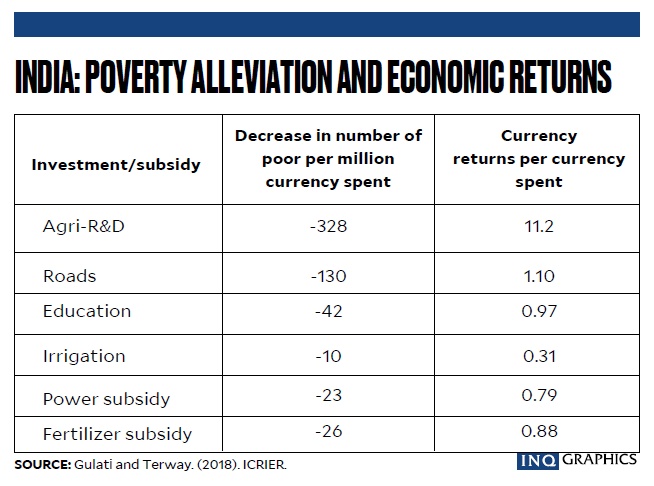What agriculture policy lessons can be learned from China and India, the two agriculture giants?
The following is from a recent article by Ashok Gulati, a famous agriculture economist, and his coauthor Sakshi Gupta, which appeared in the Financial Express of India.
Both countries have over 1.3 billion in population. China has an arable land of only 120 million hectares as compared to India with 146 million ha. With irrigation, China has a cropped area of 166 million ha versus 198 million ha for India.
In 2018, China produced $978 billion in terms of agriculture output, 2.5 times higher than India’s $394 billion. This means $5,900/ha for China and $1,900/ha for India. According to the World Bank, the former’s poverty incidence is less than five percent versus the latter’s 21 percent.
What are the main policy lessons?
First, China spends more on agriculture knowledge and innovation system, which includes agriculture research and development (R&D) and extension. It invested $7.8 billion from 2018 to 2019, some 5.6 times the amount spent by India at $1.4 billion.
Presently, India invests only 0.35 percent of its agri gross value added as compared to China’s 0.8 percent. For increasing total factor productivity, India needs to increase expenditure on R&D.
Second is on the farm incentive structure as measured by producer support estimates (PSEs). The PSE measures the output prices as well as input subsidies that farmers get in relation to a free trade scenario.
For Chinese farmers, PSE was 15.3 percent of gross farm receipts during the three-year average ending 2019. By contrast, Indian farmers had a PSE of negative 5.7 percent.
The authors conclude “that Indian farmers had been net taxed, not subsidized, despite high amounts of input subsidies. This negative PSE comes due to restrictive marketing and trade policies that do not allow Indian farmers to get free trade prices for their outputs. And this negative market price support is so strong that it exceeds even the positive input subsidy support the government gives to farmers through low prices of fertilizers, power, irrigation, agri-credit, crop insurance, etc.”
India can learn from China
“They took that path also, and, in fact, gave procurement prices to farmers that were much higher than even international prices. The result was massive accumulation of stocks of wheat, rice and corn that touched almost 300 million metric tons in 2016-17,” they said. However, India spent so much for withholding the stocks for nothing.
“India’s stock situation in July 2019 was 81 million tons as against a buffer stock norm of 41 million tons. India needs to reduce the gamut of commodities under the minimum support prices (MSP) system and keep MSPs below international prices. Else, India will also suffer from the same problems of overflowing granaries as China did,” the authors noted.
The third lesson is direct income support.
The authors claimed: “China has combined its major input subsidies in a single scheme that allows direct payment to farmers on a per hectare basis and has spent $20.7 billion in 2018-2019.”
This encouraged farmers to produce anything rather than focusing on specific crops. “Inputs are priced at market prices, encouraging farmers to use resources optimally.”
India, on the other hand, spent only $3 billion under its direct income scheme, but spent $27 billion on subsidizing fertilizers, power, irrigation, insurance and credit. This led to large inefficiencies in their use and has also created environmental problems.
The authors suggest it may be better for India to also consolidate all its input subsidies and give them directly to farmers on a per hectare basis. Prices must also be freed up from all controls.
In summary, the three lessons from China are: to invest more in R&D and innovations, improve incentives for farmers by carrying out agri-marketing reforms and collapse input subsidies into direct income support on a per hectare basis.
A related study by Gulati shows the highest impact is from investments in agriculture research and extension. The study estimated that for every million rupees spent on agriculture R&D, 328 people are brought out of poverty.
The Philippines can also learn from these lessons. Its total factor productivity growth lags compared to its Asean (Association of Southeast Asian Nations) neighbors. Poverty incidence is 2.5 times as high.
Based on the Indian experience, R&D, roads and education rank high by impact. R&D can be initiated by entrepreneurs, corporations and government institutions.
But over and above that, private investment must flow into the countryside to make agriculture productive and to reduce unusually high rural poverty.
This article reflects the personal opinion of the author and does not reflect the official stand of the Management Association of the Philippines, or MAP. The author is the co-vice chair of the MAP AgriBusiness Committee and the executive director of the Center for Food and AgriBusiness of the University of Asia and the Pacific. Feedback at map@map.org.ph; and rdyster@gmail.com. For previous articles, please visit map.org.ph
